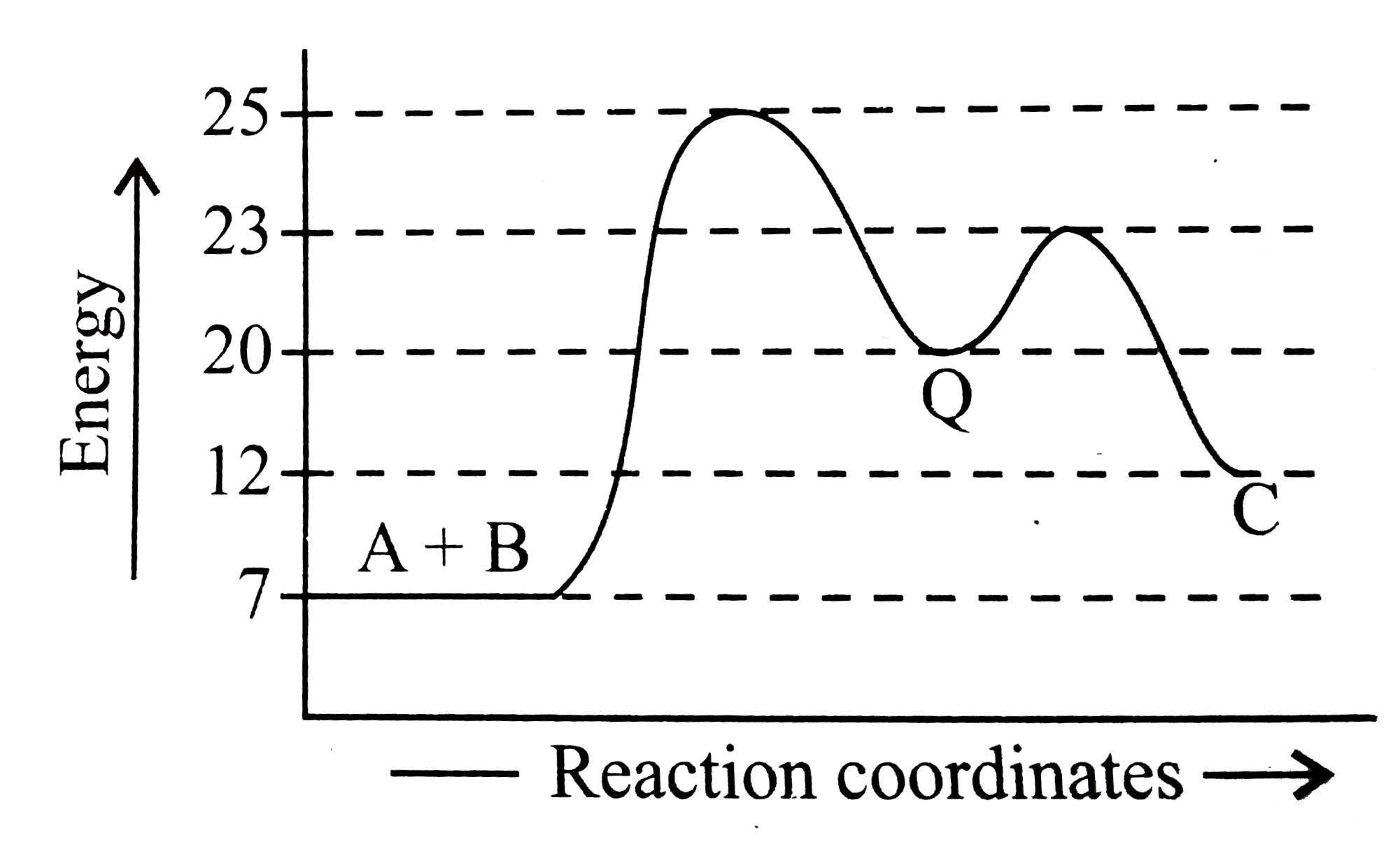Calculate the electronegativity of fluorine from the following data:
EH−H=104.4kcalmol−1,EF−F=36.6kcalmol−1
EH−F=134.3kcalmol−1,χH=2.1
To calculate the electronegativity of fluorine (X_F) using the given bond energies and the electronegativity of hydrogen (X_H), we will use the formula for electronegativity difference:
XA−XB=0.208×(EAB−12(EAA+EBB))1/2
Where:
- EAB is the bond energy of the AB bond (H-F bond in this case).
- EAA is the bond energy of the AA bond (H-H bond).
- EBB is the bond energy of the BB bond (F-F bond).
- XA is the electronegativity of element A (fluorine).
- XB is the electronegativity of element B (hydrogen).
Step 1: Identify the given values
- EH−H=104.4kcal mol−1
- EF−F=36.6kcal mol−1
- EH−F=134.3kcal mol−1
- XH=2.1
Step 2: Substitute the values into the formula
We need to find XF−XH:
XF−2.1=0.208×(134.3−12(36.6+104.4))1/2
Step 3: Calculate the average bond energy
Calculate 12(EF−F+EH−H):
12(36.6+104.4)=12(141)=70.5kcal mol−1
Step 4: Substitute back into the equation
Now substitute this value back into the equation:
XF−2.1=0.208×(134.3−70.5)1/2
XF−2.1=0.208×(63.8)1/2
Step 5: Calculate the square root
Calculate the square root:
√63.8≈7.99
Step 6: Complete the calculation
Now substitute this back into the equation:
XF−2.1=0.208×7.99
XF−2.1≈1.66
Step 7: Solve for XF
Now add 2.1 to both sides to find XF:
XF≈1.66+2.1
XF≈3.76
Final Answer
The electronegativity of fluorine is approximately 3.76.
---
- EAB is the bond energy of the AB bond (H-F bond in this case).
- EAA is the bond energy of the AA bond (H-H bond).
- EBB is the bond energy of the BB bond (F-F bond).
- XA is the electronegativity of element A (fluorine).
- XB is the electronegativity of element B (hydrogen).
- EH−H=104.4kcal mol−1
- EF−F=36.6kcal mol−1
- EH−F=134.3kcal mol−1
- XH=2.1
We need to find XF−XH:
XF−2.1=0.208×(134.3−12(36.6+104.4))1/2
Calculate 12(EF−F+EH−H):
12(36.6+104.4)=12(141)=70.5kcal mol−1
Now substitute this value back into the equation:
XF−2.1=0.208×(134.3−70.5)1/2
XF−2.1=0.208×(63.8)1/2
Calculate the square root:
√63.8≈7.99
Now substitute this back into the equation:
XF−2.1=0.208×7.99
XF−2.1≈1.66
Now add 2.1 to both sides to find XF:
XF≈1.66+2.1
XF≈3.76
The electronegativity of fluorine is approximately 3.76.
Topper's Solved these Questions
- PERIODIC CLASSIFICATION OF ELEMENTS AND GENERAL INORGANIC CHEMISTRYBOOK - CENGAGE CHEMISTRY ENGLISHCHAPTER - PERIODIC CLASSIFICATION OF ELEMENTS AND GENERAL INORGANIC CHEMISTRYEXERCISE - Ex 1.1
14 Videos
- PERIODIC CLASSIFICATION OF ELEMENTS AND GENERAL INORGANIC CHEMISTRYBOOK - CENGAGE CHEMISTRY ENGLISHCHAPTER - PERIODIC CLASSIFICATION OF ELEMENTS AND GENERAL INORGANIC CHEMISTRYEXERCISE - Ex 1.1 (Very Short)
22 Videos
- PERIODIC CLASSIFICATION OF ELEMENTS AND GENERAL INORGANIC CHEMISTRYBOOK - CENGAGE CHEMISTRY ENGLISHCHAPTER - PERIODIC CLASSIFICATION OF ELEMENTS AND GENERAL INORGANIC CHEMISTRYEXERCISE - Exercises (Archives )Subjective
4 Videos
- P-BLOCK GROUP 14 - CARBON FAMILYBOOK - CENGAGE CHEMISTRY ENGLISHCHAPTER - P-BLOCK GROUP 14 - CARBON FAMILYEXERCISE - Exercises Archives (Subjective)
9 Videos
- PURIFICATION OF ORGANIC COMPOUNDS AND QUALITATIVE AND QUANTITATIVE ANALYSISBOOK - CENGAGE CHEMISTRY ENGLISHCHAPTER - PURIFICATION OF ORGANIC COMPOUNDS AND QUALITATIVE AND QUANTITATIVE ANALYSISEXERCISE - Assertion Reasoning Type
5 Videos
Similar Questions
Calculate electronegativity of carbon at Pauling scale Given that :
EH−H=104.2kcalmol−1EC−C=83.1kcalmol−1 ,
EC−H=98.8kcalmol−1.
Electronegativity of hydrogen =2.1.
View SolutionCalculate the enthalpy of formation of ammonia from the following bond energy data:
(N−H)bond=389kJmol−1,(H−H)bond=435kJmol−1, and (N≡N)bond=945.36kJmol−1.
View Solution
Knowledge Check
The enthalpy of formation of ammonia when calculated from the following bond energy data is (B.E. of N−H,H−H,N≡N is 389 kJ mol−1,435 kJ mol−1,945.36 kJ mol−1 respectively)
A−41.82 kJ mol−1B+83.64 kJ mol−1C−945.36 kJ mol−1D−833 kJ mol−1
Calculate the lattice energy from the following data (given 1eV=23.0kcalmol−1)
i. ΔfHɵ(KI)=−78.0kcalmol−1
ii. IE1 of K=4.0eV
iii. ΔdissHɵ(I2)=28.0kcalmol−1
iv. ΔsubHɵ(K)=20.0kcalmol−1
v. EA of I=−70.0kcalmol−1
vi. ΔsubHɵ of I2=14.0kcalmol−1
View SolutionFrom the following data, calculate the standard enthalpy of formation of propane ΔfHΘCH4=−17kcalmol−1
ΔfHΘC2H6=−24kcalmol−1,BE(C−H)=99kcalmol−1
(C−C)=84kcalmol−1.
View SolutionFind the electron affinity of chlorine from the following data. Enthalpy of formation of LiCI is −97.5kcalmol−1, lattice energy of LiCI=−197.7kcalmol−1. Dissociation energy of chlirine is 57.6kcalmol−1, sublimation enthalpy of lithium =+38.3kcalmol−1, ionisation energy of lithium =123.8kcalmol−1.
View SolutionCalculate the lattice energy of the reaction
Li⊕(g)+CIΘ(g)→LiCI(s)
from the following data:
ΔsubHΘ(Li)=160.67kJmol−1,12D(CI2)=122.17kJmol−1<br>IP(Li)=520.07kJmol−1,EA(CI)=−365.26kJmol−1 and ΔfHΘ(LiCI)=−401.66kJmol−1
View SolutionCalculate Ksp for AgCI. Given:
ΔfHΘAg⊕=25.3kcalmol−1
ΔfHΘC1Θ=−40.0kcalmol−1
ΔfHΘAgC1=−30.36kcalmol−1
SΘAg⊕,SΘC1Θ, and SΘAgC1are 17.7,13.2 and 23.0calmol−1
View SolutionCalculate the enthalpy change during the reaction :
H2(g)+Br2(g)→2HBr(g)
Given, eH−H=435kJmol−1,eBr−Br=192kJmol−1 and eH−Br=368kJmol−1.
View SolutionIn a multistep reaction such as A+B→Q→C. The potential energy diagram is shown below. What is Ea for the reaction Q→C ?

(a)3kcalmol−1
(b)5kcalmol−1
(c) 8kcalmol−1
(d) 11kcalmol−1
View Solution
